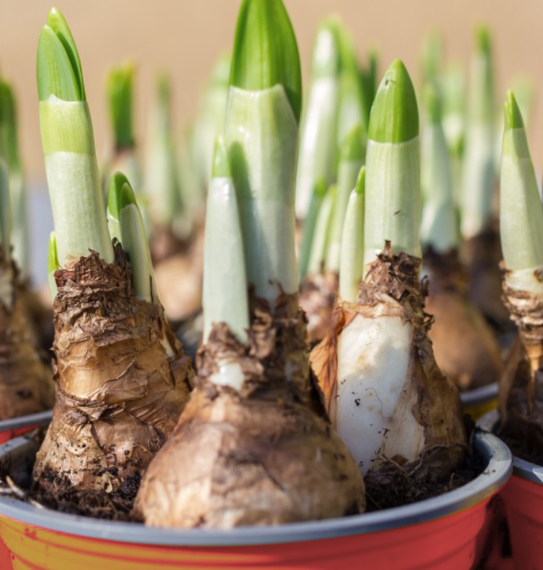
FORCING BULBS FOR INDOOR BEAUTY

October is the time of the year to begin potting your favorite spring bulbs to prepare them for winter flowering. Tulips, narcissus (daffodils), hyacinths, crocus, scillas, grape hyacinths, and lily of the valley can be forced into flower in late winter and early spring. A pot of tulips on the windowsill in February can make a winter-worn gardener renew the desire to survive the winter.
Only top quality, good-sized bulbs should be used. Your neighborhood greenhouse operator will tell you the varieties that are best suited for forcing. Don’t mix varieties in the same container, since they vary in their dates of flowering.
Planting
Begin by potting the bulbs in clean, sterile clay or plastic pots. Normally the “noses” of the bulbs are exposed. Do not bury the bulbs. The soil should be an open mixture of good garden loam (three parts), peat moss (two parts), and sand (one part). Don’t worry about soil fertility or feeding bulbs because they have enough stored food to flower one time.
Plant the bulbs close together in the pot. Usually 6 tulip bulbs, 3 hyacinths, 6 daffodils, or 15 crocuses, will fit into a 6-inch pot. The flat side of the tulip bulb should be placed next to the rim of the pot since the largest leaf will always emerge and grow on that side, producing a more desirable looking pot.
It’s extremely important that bulbs be handled with care at all times. Never allow the bulbs to be in temperatures above 65 degrees F. When planting, the pot should be loosely filled with soil. Don’t press the bulbs into the soil. Allow 1/4-inch of space at the top of the pot so it can be watered easily. The bulbs should be watered immediately upon planting, and thereafter the soil should never be allowed to become dry.
Cold Treatment
Bulbs must be given a cold temperature treatment of 35– 48 degrees F for a minimum of 12–13 weeks. A cold frame, an unheated attic or cellar, or even your refrigerator’s vegetable section can provide this cold treatment. In the refrigerator, the pots should be covered with plastic bags that have had a few breathing holes punched in them. Cover the pots with 10 inches of soil, and then cover with 10 inches of mulch (hay, sawdust, or leaves). The bulbs must not be allowed to freeze.
Forcing in Pots
Mark your calendar to remind yourself when the first pots can be removed from storage for forcing to begin. If planted October 1, bring the first pots into the home right after Christmas. For a continuous supply of flowers, bring in a few pots at weekly intervals. On the average the bulbs will flower in three to four weeks. Closer to spring, they flower more rapidly.
In the home, place the pots in a cool, sunny location. A temperature of 50–60 degrees F is preferred for the first week or until the shoots and leaves begin to expand. Then, they can be moved to warmer locations such as the living room. Avoid direct sunlight. Hyacinths may have a tendency not to have an elongated flower stem and “stick” in the clasp of leaves. Placing the plants in the dark for a few days or placing a paper cone over the plants in order to “draw” the flower out of the bulbs may overcome this problem. Warmer temperatures will result in rapid growth. Once the bulbs are blooming, move the pots to a cool location each night. The cooler temperatures will prolong the life of the flowers. Small pots of crocus can even be placed in your refrigerator overnight.
Discard tulips, narcissus, crocus, and hyacinths after flowering as they normally are “spent” and are not likely to ever flower satisfactorily again.
Forcing in Water
Hyacinths, crocus, and narcissus also can be forced in water. Special clear, glass vases are made for hyacinths or crocus. The bulb is placed in the upper portion, water in the lower portion. The vase is then kept in a cool, dark room (preferably under 50 degrees F) for four to eight weeks until the root system has developed and the top elongates. At this point it should be placed in a bright window, where the plant soon will blossom.
Bunch-flowering narcissus, such as Paper White and Soleil d’Or, can be grown in shallow pans of water filled with crushed rocks or pebbles. The bulbs should be secured in the pebbles deeply enough so that the basal plate is in contact with the water. Keep them in a cool, dark room for several weeks to ensure root growth, and then place in a sunny location. Each bulb will send up several flower stems bearing many tiny blossoms.
Discard these plants after flowering.
Deborah L. Brown and Harold F. Wilkins © 2006 Regents of the University of Minnesota. All rights reserved.

